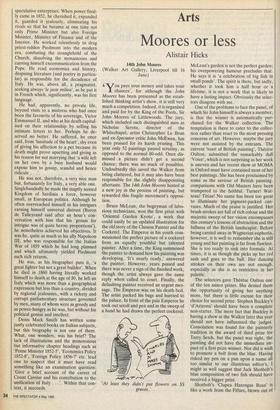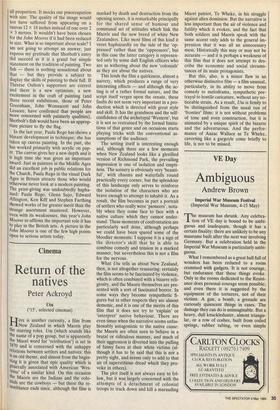Arts
Moores or less
Alistair Hicks
14th John Moores (Walker Art Gallery, Liverpool till 16 June) 6 ou pays your money and takes your chances', for although the John Moores has been presented as the estab- lished thinking artist's show, it is still very much a competition. Indeed, it is organised and paid for by the King of the Pools, Sir John Moores of Littlewoods. The jury, which included such distinguished men as Nicholas Serota, director of the Whitechapel, artist Christopher Le Brun and ex-Spectator critic John McEwen, has been praised for its harsh pruning. This year only 52 paintings passed scrutiny, as opposed to the normal 80-odd. Once dis- missed a picture didn't get a second chance; there was no stack of possibles. Undoubtedly this saved the Walker from being cluttered, but it may also have been responsible for the slightly disappointing aftertaste. The 14th John Moores hinted at a new joy in the process of painting, but rewarded this fragile movement's opposi- tion.
Bruce McLean, the bogeyman of labo- rious technicians, won the first prize with 'Oriental Garden Kyoto', a work that could easily be an updated illustration for the old story of the Chinese Painter and the Cockerel. The Emperor in his youth com- missioned the perfect picture of a cockerel from an equally youthful but talented painter. After a time, the King summoned the painter to demand how his painting was developing. 'It's nearly ready,' answered the painter. However, years passed and there was never a sign of the finished work, though the artist always gave the same reply when called to court. Finally, the defaulting painter received an urgent mes- sage. The Emperor was on his death bed. The artist packed his bags and hurried to the palace. In front of the pale Emperor he took out scroll and pen and in the sweep of a hand he had drawn the perfect cockerel.
'At least they didn't put flowers on SS
graves.'
McLean's garden is not the perfect garden; his overpowering humour precludes that. He says it is 'a celebration of big fish in small ponds'. The spirit is there, but sadly, whether it took him a half hour or a lifetime, it is not a work that is likely to have a lasting impact. Obviously the selec- tors disagree with me. One of the problems to face the panel, of which Sir John himself is always a member, is that the winner is automatically pur- chased for the Walker collection. The temptation is there to cater to the collec- tion rather than react to the most pressing concerns of art. However, maybe the jury were not assisted by the entrants. The current 'toast of British painting', Therese Oulton, submitted the remarkably dull 'Voice', which is not surprising as her work is uneven and her recent show at MOMA in Oxford must have contained most of her best paintings. She has been proclaimed by some as the saviour of British painting. comparisons with Old Masters have been trumpeted to the faithful. Turner! Wat- teau! Titian! No name has been too great to illuminate her pigment-packed can- vases. Much of the praise is justified. Her brush strokes are full of rich colour and the majestic sweep of her vision encompasses this century's lessons of abstraction and the fullness of the British landscapist. Before being carried away in Wagnerian euphoria, however, it is well to remember she is still young and her painting is far from flawless. She is too ready to sink into formula. At times, it is as though she picks up her red sash and goes to the ball. Her dancing strokes on their own are not enough, especially as she is so restrictive in her palette.
The selectors gave Therese Oulton one of the ten minor prizes. She denied them the opportunity of giving her anything more, but there is little excuse for their choice for second prize. Stephen Buckley's 'd'Arizona' should have been a complete non-starter. The mere fact that Buckley is having a show at the Walker later this year should not have influenced the judges. Consolation was found for the painterly tradition in the award of third prize for Terry Setch, but the panel was right, the painting did not have the immediate im- pact of a first prize winner. Nor did it wish to promote a bolt from the blue. Having risked my pen on a pun upon a name all too similar to our illustrious editor's, I might as well suggest that Jack Shotbolt's blue composition of two fish should have received a bigger prize.
Shotbolt's 'Clupea Harengus Rosa' is like a work from the Fifties, blown out of
all proportion. It mocks our preoccupation with size. The quality of the image would not have suffered from appearing on a canvas 12 x 18 inches instead of one over 2 x 3 metres. It wouldn't have been chosen for the John Moores if it had been reduced in size. What is so important about scale? I am not going to attempt an answer, just express my gratitude that Shotbolt's entry did succeed as it is a grand but simple statement on the tradition of painting. Two fish — there is nothing sensational about that — but they provide a subject to display the skills of painting to their full. If Therese Oulton's supporters are correct and there is a new optimism, a new excitement in the craft of painting (and three recent exhibitions, those of Peter Greenham, John Wonnacott and John Lessore, have confirmed that people are more concerned with painterly qualities), Shotbolt's fish would have been an approp- nate picture to fly the flag.
In the last year, Paula Rego has shown a blatant development in technique; she has taken up canvas painting. In the past, she has worked primarily with acrylic on pap- er. The canvas gives her a new depth and it is high time she was given an important award. Just as painters in the Middle Ages did an excellent job in public relations for the Church, Paula Rego in the visual Dark Ages in Britain attracts those who would Otherwise never look at a modern painting. The prize-giving was undoubtedly hapha- zard: Paula Rego, Glenn Sujo, Edward Allington, Ken Kiff and Stephen Farthing Showed works of far greater merit than the strange assortment mustered. However, even with its weaknesses, this year's John Moores re-affirms the important role it has to play in the British arts. A picture in the John Moores is one of the few high points Open to serious artists today.



















































 Previous page
Previous page